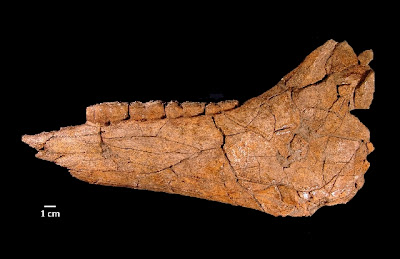
It marks the first time the extinct horse, known as Equus scotti, has been definitively identified in Southern Nevada.
Adding to the excitement over the discovery is who helped make it. The first few fragments of teeth that led to the find were collected by a retired high school history teacher.
Pat Weidknecht was helping out on last year’s dig as a reward for her work as a volunteer site steward for the fossil-laden swath of public land along the Upper Las Vegas Wash.
“It’s like a little kid that’s been allowed to play in the dirt and he finds the gold ring,” Weidknecht said. “All I thought I was doing was digging up old bones.”
Scientists have been unearthing fossilized bones from ice age horses here and across the Southwest for years, but it’s rare to find just the right pieces to allow for species identification, Scott said.
Cue the hit 1972 song by the band America.
“You might say we’ve been through the desert on a horse with no name,” he joked. “Until now.”
Based on the teeth, Scott said this particular horse was probably about a year old when it died. And thanks to extremely detailed radiocarbon dating of the rock where the fossils were found, researchers can get pretty specific about when that happened: 13,375 years ago, give or take a century.
Scott described the horse as “big enough to ride” but not much of a Triple Crown threat. Equus scotti ran shorter and stockier than present day thoroughbreds.
Weidknecht said she teased Scott when he first told her what the fossilized bones might be. “I told him it should be called Equus patti.”
For the record, Scott notes that the extinct horse was not named for him. It was first described by another researcher with the same last name back in 1900.
Scott confirmed the find through painstaking comparisons with other fossilized horse teeth collected at the La Brea Tar Pits and other museums.
He suspects the horse was a female, but he will probably never know for sure.
News of the discovery comes just days after Nevada lawmakers in Congress introduced legislation to designate the fossil-rich hills north of Las Vegas as the state’s newest — and right now only — national monument.
If approved, Tule Springs Fossil Beds National Monument will take in 22,650 acres bordering Desert National Wildlife Refuge, the Las Vegas Paiute Indian Reservation and the cities of Las Vegas and North Las Vegas.
The measure mirrors a proposal that was introduced last year but failed to advance while the previous Congress was in session.
Thousands of fossils have already been pulled from the Upper Las Vegas Wash, and as many as 10,000 more may still await discovery.
Confirming that Equus scotti was here extends the known range of the horse and could help scientists better understand what killed it off. In that way, Scott said, this find could prove to be more important than other, more headline-grabbing discoveries in the wash.
In December, the same San Bernardino County team identified fossils from a saber-tooth cat. Later that month, University of Nevada, Las Vegas researchers announced the discovery of a bone from an extinct dire wolf.
“To me, this is why we need an ice age park,” said Weidknecht, who began keeping watch over the area about five years ago, after retiring from nearby Shadow Ridge High School.
Geologist and paleontologist Kathleen Springer heads up the San Bernardino County team, and she was the one who first spotted the site where the horse was eventually found way back in 2003, during an exhaustive survey of the Upper Las Vegas Wash.
She said the site was easy enough to see for someone who knew what to look for. For one thing, there was a giant tooth from a mammoth sticking right out of the ground.
“I was very excited,” Springer recalled. “I think this was the very first week we were out there. It might have even been the first day.
“We were finding fossils from the moment we had boots on the ground.”
They’re not done, either.
Springer expects her site to yield even more scientific treasures, including additional mammoth bones and maybe a few more pieces of the all-important horse.
“The site is not played out, that’s for sure,” Springer said.


No comments:
Post a Comment